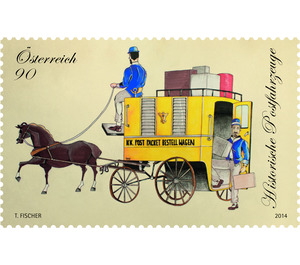Post vehicles - Austria / II. Republic of Austria 2014 - 90 Euro Cent
Theme: History & Politics
| Country | Austria / II. Republic of Austria |
| Issue Date | 2014 |
| Face Value | 90.00 |
| Edition Issued | 230,000 |
| Printing Type | offset |
| Stamp Type | Commemorative |
| Item Type | Stamp |
| Chronological Issue Number | 2495 |
| Chronological Chapter | OOS-OE2 |
| SID | 564315 |
| In 67 Wishlists | |
For more than 250 years, Austrian stagecoaches not only handled the delivery of parcels and letters but were also an important means of passenger transport. For the special stamp issued this year, which continues the series "Historic Postal Vehicles", which began in 2013, a k. k. Parcel post wagon from around 1830 a fitting nostalgic motif. Already in the Roman province Noricum a postal service was essential to keep the connection to the capital Rome. A unified Austrian postal system was built centuries later under Emperor Maximilian I. He commissioned the Taxis family in 1490 with messenger rides from Innsbruck to present-day Belgium, as Maximilian was by marriage also Duke of Burgundy and as such was sometimes there. In the middle of the 17th century, the noble family Paar received the postal service in a large part of the Austrian ancestral lands as a fief. In 1722, Charles VI. the post office under state hands, and in 1748 Maria Theresia also introduced a post office mail, which - in contrast to the mounted messengers - could transport by coach also bulky shipments as well as passengers from post office to post office and across the entire monarchy. Around 1750 there was a regular stagecoach traffic, and at the turn of the century the road network was expanded, which converged in Vienna, but also paid special attention to the important port and commercial city of Trieste and a quick crossing of the Brenner. The stagecoach traffic boomed at that time, so that at the beginning of the 19th century a regular timetable could be established. The journey in cramped carriages on iron-spoked wooden spoked wheels was not very pleasant, contrary to romantic ideas. The driving speed of an average of eight kilometers per hour also promised a rather tedious undertaking - and yet the stagecoach brought a huge and significant progress in travel. However, the invention of the railroad, which brought a new travel comfort and a shorter journey time, meant an incision for the stagecoach. From 1850, the railway mail was also created with its own mail coach - but the carriages were still needed as feeder for the train or for routes that were not yet connected to the rail network needed. In 1907, the director general of the Austrian postal and telegraph administration Friedrich Wagner inaugurated the first post bus and thus sealed the end of the stagecoach era. However, the stagecoach has not been forgotten until now - it is a magnet in many museums, and nostalgic stagecoach rides are also very popular.


